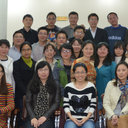Interactions among HCLS1, HAX1 and LEF-1 proteins are essential for G-CSF-triggered granulopoiesis.
کلید واژه ها
خلاصه
We found that hematopoietic cell-specific Lyn substrate 1 (HCLS1 or HS1) is highly expressed in human myeloid cells and that stimulation with granulocyte colony-stimulating factor (G-CSF) leads to HCLS1 phosphorylation. HCLS1 binds the transcription factor lymphoid-enhancer binding factor 1 (LEF-1), transporting LEF-1 into the nucleus upon G-CSF stimulation and inducing LEF-1 autoregulation. In patients with severe congenital neutropenia, inherited mutations in the gene encoding HCLS1-associated protein X-1 (HAX1) lead to profound defects in G-CSF-triggered phosphorylation of HCLS1 and subsequently to reduced autoregulation and expression of LEF-1. Consistent with these results, HCLS1-deficient mice are neutropenic. In bone marrow biopsies of the majority of tested patients with acute myeloid leukemia, HCLS1 protein expression is substantially elevated, associated with high levels of G-CSF synthesis and, in some individuals, a four-residue insertion in a proline-rich region of HCLS1 protein known to accelerate intracellular signaling. These data demonstrate the importance of HCLS1 in myelopoiesis in vitro and in vivo.


